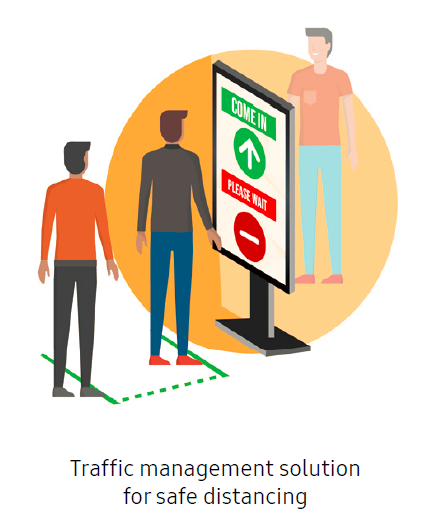Navigating the new normal: Using smart digital signage in a changed retail environment
03 June 2020, Ridderkerk
After facing an unprecedented disruption in business operations, retailers across multiple industries are in various stages of reopening in a vastly changed environment.
Consumer perceptions have shifted, daily behaviors have changed and many businesses are currently exploring new ways to conduct business effectively, while implementing new health guidelines and protocols around safe social distancing. The role of technology has never been more important than it is today, particularly for retailers that must now reimagine the shopping experience while staying transparent and flexible as new developments arise. Digital display technology provides an immediate solution to help deliver important information clearly and accurately, from monitoring lines inside and outside the store, wayfi nding and navigation, checking out and more.
In-store communication in the new retail landscape
To help create the safest possible environment for businesses reopening to the public, health offi cials have encouraged a number of adaptations for retail stores including increased cleaning procedures and physical distancing measures. Stores must ensure they are following the guidelines of health experts, but retailers must also instill confi dence in their customers, taking proper precautions and prioritizing health and safety. Many retailers have also had to deal with supply chain and fulfillment issues resulting in poor customer experiences. It is critical retailers create as consistent a shopping experience as possible to deliver on brand values and fi nd ways to emphasize structure and calm. Any change to emphasize customer health is important and it’s just as critical those changes are communicated effectively. Physical retail locations face a number of challenges communicating with customers in-store, but technology advancements can solve many common concerns. At every customer touchpoint, from the store entrance to checkout, retailers should be reviewing what changes can be made and identifying the best tools available.
The role of digital displays in retail transformation
As businesses explore new scenarios that provide a safe and seamless reopening experience, there are several areas in which digital display technology can deliver immediate value — through effi cient, scalable and cost-effective solutions for retail businesses of any size.
Customer communication
- Safe distancing
Many retailers will need to reinforce important safe distancing messaging alongside wayfi nding information such as where to find cleaning items, where to queue for checkout and more. Digital displays can be more visible and prominent to customers than other printed materials and can be more easily updated when needed. Dynamic displays can even change to communicate important health notices when customers pass by.
- Health notices
Consumers need to feel confi dent they’re protected. Displays allow stores to effectively and consistently encourage safe hygiene, safe spacing and the use of store-provided cleaning items such as hand sanitizer or disinfecting wipes. Post the latest and most benefi cial health information for customers when they need it while also appropriately continuing to communicate promotional materials or product details even on the same display.
- Store operations
Quickly communicate changes in product availability, store hours or other operational changes that may need to adjust in near real-time. Digital displays provide more engaging content via high resolution video, both to demonstrate safe behavior and to showcase more detailed information about a store’s cleaning procedures via video or motion graphics, that can’t be communicated as effectively in static text.
Managing foot traffic
- Store entrance
Some retailers require a system to manage the number of customers inside stores. Pairing displays with cameras or door operating systems can help safely manage customer flow, ensure safe social distancing and limit capacity. These displays can also provide real-time messaging information for customers in line including wait times, appropriate queuing protocols or other promotional information. Content on displays can be managed automatically using content management software. Camera systems* combined with content management software can also automatically showcase the most appropriate content for individual customers.
- Customer screening
As some stores implement customer screening such as temperature checking procedures with infrared thermometers, thermal scanners* or other technology, display solutions can also be linked to more quickly and efficiently monitor and screen customers as needed.
- Reconfigure store layouts
Complete display and retail monitoring Solutions can analyze high foot traffic Location to help inform reconfigured store layouts as needed to make social distancing easier in-store and more quickly conform to local government health directives.
Customer Service
- Touch displays
Retailers will need to identify ways to help shoppers find what they need, while also giving them the space they need to feel comfortable. Touch display solutions can help customers feel safe by decreasing face-to-face contact
without sacrificing customer service.
- Outdoor displays
Window-facing and other outdoor displays can also provide better communication options for stores looking to provide alternative solutions for customers unable or unwilling to enter a physical store.
- Full ecosystem
A complete retail tech solution can be managed remotely to ensure clear and consistent communication across store locations, displays are linked and dynamic, providing the most useful information when it’s needed and adapted to local needs and conditions. Kiosk touch display systems can be linked to app-ordering for contactless payments and stores can create a complete customer ecosystem providing meaningful and personalized interactions with customers in-store.
Samsung’s wide range of display solutions provide retailers of any size with efficient and scalable tools to transition in this environment and help create a safe and welcoming environment for customers.


